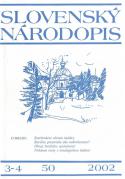MOŽNOSTI KONŠTRUOVANIA OBRAZU TRADIČNEJ RURÁLNEJ KULTÚRY KARTOGRAFICKOU METÓDOU
POSSIBLE WAYS OF CONSTRUCTING THE PICTURE OF TRADITIONAL RURAL CULTURE BY USING CARTOGRAPHIC METHOD
Author(s): Rastislava StoličnáSubject(s): Customs / Folklore, Cultural Anthropology / Ethnology, Methodology and research technology, Rural and urban sociology
Published by: Ústav etnológie a sociálnej antropológie Slovenskej akadémie vied
Keywords: traditional rural culture; cartographic method;
Summary/Abstract: Slovakia belongs to countries possessing an ethnographic atlas where ethno-cultural phenomena are systematized into a construction based on territorial and chronological principle. The Ethnographic Atlas of Slovakia (EAS) was based on the first-hand research of the rural environment in the years 1971-1975. A wide range of questions concerning traditional folk culture is included in the questionnaire. There were 170 topics studied in 250 localities (from total 3 155) event) spread in the whole Slovak territory. The EAS is thus one of the possible constructed pictures of traditional Slovak culture. In general it can be said that the EAS managed to grasp the so-called cultural change. This is so thanks to the fact that the researches in the 70s covered the development and changes of the life style and culture in the rural communities from the end of the 19th century till the half of the 20th century using the cartographic interpretation. This basic attribute of culture is manifested in the generative phase - it depicts the birth and development of the local cultures as well as Slovak Folk culture as a whole. The other attribute is expressed in the transformation phase - where formal and functional changes and extinction of particular ethno-cultural phenomena could be seen. There are two basic types of cultural change in the socio-cultural system of the traditional culture: endogenous inner and exogenous-external. The endogenous change is a result of the transformation of cultural elements and their configuration in the system. The form of this change is innovation as a new way of reaching particular goals by the means of invention. Exogenous change is processes that ensue from the interaction of various socio-cultural systems. A typical example of this kind of a change is acculturation and one of its basic forms is apart from migration of people also the cultural diffusion - a process of spreading, dispersion and transmission of the cultural elements and their configurations from one community to another. Whereby it is rarely one-way process usually it is a result of a mutual interaction of various socio-cultural systems. The research material of the EAS enabled first of all the analysis from the continuity and discontinuity perspective so called historical, cultural and collective memory of the studied rural communities. One of the most important contributions of the EAS is the explanation of the connection between culture and natural environment. The results of the EAS provide with links between culture and organisation of human thinking. In this context culture is perceived as a system of knowledge, classification and communication. There are many maps in the EAS comprising folk terms denominating particular ethno-cultural phenomena. As a result of constructing these maps, which represent the basic cultural zones of the Slovak territory in the ethno-cultural system as a whole, a single final map of the EAS came into being: ‘Regions of the Folk Culture After the EAS'. In the last few years a research of the traditional rural culture has taken place and the cartographic method is used even in the environment of the Slovak minorities in Europe (Hungary, Romania, Poland, Croatia, Yugoslavia. Ukraine).
Journal: Slovenský národopis
- Issue Year: 50/2002
- Issue No: 3(4)
- Page Range: 369-375
- Page Count: 7
- Language: Slovak

